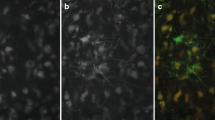Abstract
Introduction
Diffuse pontine gliomas remain a challenging and frustrating disease to treat. The survival rates for these high-grade brainstem tumors (BSTs) is dismal and optimal therapy has yet to be determined. The development of a satisfactory brainstem tumor model is necessary for testing new therapeutic paradigms that may prolong survival.
Materials and methods
We report the surgical technique, functional testing, and histopathological features of a novel brainstem tumor model in rats. Female Fischer 344 rats (n=45) were randomized to receive an injection of either 3 μl of 9L gliosarcoma cells (100,000 cells, n=), 3 μl of F98 glioma cells (100,000 cells, n=10), or 3 μl of medium (Dulbecco’s modified eagle medium) into the pontine tegmentum. Using a cannulated guide screw system, implanted in the skull of the animal, we injected each group at coordinates 1.4 mm right of the sagittal and 1.0 mm anterior of the lambdoid sutures, at a depth of 7.0 mm from the dura. The head was positioned 5° from horizontal before injection. The rats were post-operatively evaluated for neurological deficits using an automated test. Kaplan–Meier curves were generated for survival and disease progression, and brains were processed postmortem for histopathology.
Results and discussion
9L and F98 tumor cells grew in 100% of animals injected and resulted in a statistically significant mean onset of hemiparesis of 16.5±0.56 days (P=0.001, log-rank test), compared to animals in the control group which lacked neurological deficits by day 60. The animals with tumor cells implanted demonstrated significant deterioration of function on the automated rod testing. Animals in the control group showed no functional or pathological signs of tumor. Progression to hemiparesis was consistent in all tumor-injected animals, with predictable onset of symptoms occurring approximately 17 days post-surgery. The histopathological characteristics of the 9L and F98 BSTs were comparable to those of aggressive human BSTs.
Conclusion
The establishment of this animal tumor model will facilitate the testing of new therapeutic paradigms for the treatment of BSTs.






Similar content being viewed by others
References
Albright AL (1996)Diffuse brainstem tumors: when is a biopsy necessary? Pediatr Neurosurg 24:252–255
Albright AL, Guthkelch AN, Packer RJ, Price RA, Rourke LB (1986) Prognostic factors in pediatric brain-stem gliomas. J Neurosurg 65:751–755
Allen JC, Siffert J (1996) Contemporary chemotherapy issues for children with brainstem gliomas. Pediatr Neurosurg 24:98–102
Barker M, Hoshino T, Gurcay O (1973) Development of an animal brain tumor model and its response to therapy with 1,3-bi(2chloroethyl)-1-nitrosurea. Cancer Res 33:976–986
Barth RF (1998) Rat brain tumor models in experimental neuro-oncology: The 9L, C6, T9, F98, RG2 (D74), RT-2 and CNS-1 gliomas. J Neurooncol 36:91–102
Benda P, Someda K, Messer J, Sweet WH (1971) Morphological and immunochemical studies of rat glial tumors and clonal strains propagated in culture. J Neurosurg 34:310–323
Carson BSS, Guarnieri M (2002) Local therapy for brain tumors. Adv Clin Neurosci 12:89–99
Epstein F, Wisoff JH (1988) Intrinsic brainstem tumors in childhood: surgical indications. J Neurooncol 6:309–317
Griffitt W, Glick RP, Lichtor T, Haughton DE, Cohen EP (1999) Development of a new mouse brain tumor model using implantable micro-cannulas. J Neurooncol 41:117–120
Guarnieri M, Carson BS, Khan A, Penno MB, Jallo GI (2005) Flexible versus rigid catheters for chronic administration of exogenous agents into central nervous system tissues. J Neurosci Methods 144:147–152
Guerin C, Olivi A, Weingart JD, Lawson HC, Brem H (2004) Recent advances in brain tumor therapy: local intracerebral drug delivery by polymers. Invest New Drugs 22:27–37
Jallo GI, Biser-Rohrbaugh A, Freed D (2004) Brainstem gliomas. Childs Nerv Syst 20:143–153
Jallo GI, Penno MB, Sukay L et al (2005) Experimental models of brainstem tumors: development of a neonatal rat model. Childs Nerv Syst 21:399–403
Jounaidi Y, Waxman DJ (2004) Use of replication-condition adenovirus as a helper system to enhance delivery of P450 prodrug-activation genes for cancer therapy. Cancer Res 64:292–303
Lee FT Jr, Chosy SG, Naidu SG et al (1997) CT depiction of experimental liver tumors: contrast enhancement with hepatocyte-selective iodinated triglyceride versus conventional techniques. Radiology 203:465–470
Lee J, Jallo GI, Guarnieri M, Carson BS, Penno MB (2005) A novel brainstem tumor model: guide screw technology with functional, radiological and histopathological characterization. Neurosurg Focus 18:Article 11
Littman P, Jarrett P, Bilaniuk LT et al (1980) Pediatric brain stem gliomas. Cancer 45:2787–2792
Madajewicz S, Chowhan N, Tfayli A et al (2000) Therapy for patients with high-grade astrocytoma using intraarterial chemotherapy and radiation therapy. Cancer 88:2350–2356
Occhiogrosso G, Edgar MA, Sandberg DI, Souweidane MM (2003) Prolonged convection-enhanced delivery into the rat brainstem. Neurosurgery 52:388–394
Rand RW, Snow HD, Elliott DG, Bubbers JE, Barbaric ZL, Brown WJ (1982) Thermo-magnetic surgery for experimental renal cancer. J Urol 128:618–620
Rozas G, Guerra MJ, Labandeira-Garcia JL (1997) An automated rotarod method for quantitative drug-free evaluation of overall motor deficits in rat models of parkinsonism. Brain Res Protoc 2:75–84
Salcman M, Scott EW, Schepp RS, Knipp HC, Broadwell RD (1982) Transplantable canine glioma model for use in experimental neuro–oncology. Neurosurgery 11:372–381
Schmidek HH, Nielsen SL, Schiller AL, Messer J (1971) Morphological studies of rat brain tumors induced by N-nitrosomethylurea. J Neurosurg 34:335–340
Storm PB, Moriarity JL, Tyler B, Burger PC, Brem H, Weingart J (2002) Polymer delivery of camptothecin against 9L gliosarcoma: release, distribution, and efficacy. J Neuro-oncol 56:209–217
Wechsler H, Ramadan MA, Pfeiffer SE (1979) Morphologic and biochemical characteristics of transplantable neurogenic tumors induced by N-ethyl-N-nitrosourea in inbred BD IX rats. J Natl Cancer Inst 62:811–817
Weizsaecker M, Deen DF, Rosenblum ML, Hoshino T, Gutin PH, Barker M (1981) The 9L rat brain tumor: description and application of an animal model. J Neurol 224:183–192
Wu Q, Tyler B, Sukay L et al (2002) Experimental rodent models of brainstem tumors. Vet Pathol 39:293–299
Acknowledgements
We would like to thank Norman Barker for histology and Ian Suk for his wonderful illustrations.
Author information
Authors and Affiliations
Corresponding author
Rights and permissions
About this article
Cite this article
Jallo, G.I., Volkov, A., Wong, C. et al. A novel brainstem tumor model: functional and histopathological characterization. Childs Nerv Syst 22, 1519–1525 (2006). https://doi.org/10.1007/s00381-006-0174-8
Received:
Published:
Issue Date:
DOI: https://doi.org/10.1007/s00381-006-0174-8




